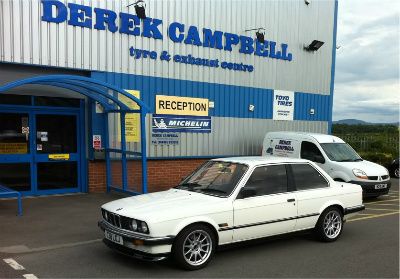Chapter 52: Custom Pistons and the road to financial ruin.
In this exciting episode we'll be revealing the closely guarded secrets of how to f*ck up a
custom piston order, quickly followed with a "how to" guide on using a kitchen bread knife
to remove a kidney with a view to selling it on ebay.
But, before we get to that, it's probably best we deal with question of why we wanted custom
pistons in the first place. Below is a picture of a Mahle standard piston for the S14 M3 engine.
If you should happen to wander in to your local dealer with a pot of gold large enough,
four of these little carefully machined slugs of aluminium can be obtained...........

So, why didn't I use these? Three main reasons really, increase the valve relief's,
changing the engine's compression ratio, and reducing piston weight, and of course not forgetting the most
important of all, my seemingly unavoidable irritating habit of complicating everything.
Valve relief's.
Due to the design of the S14 engine, the valves come in quite close proximity
to the top of the pistons while the engine is running and as such the top of the
piston has 4 little valve relief notches cut out of it to avoid any disastrous contact
between the two..........

When running standard diameter valves and standard lift camshafts all this works
as it was designed too. However, when (like I am) you change to oversize valves and
higher lift camshafts, these relief's cut in to the top of the standard pistons are usually
insufficient to offer the proper clearance any more. The Schrick 284 degree inlet and 276 degree
cams being used in this build can be considered relatively mild in the large scope of whats available
out there for this engine, and as such seem to be right on the border of being usable with standard
valve relief's.
As a guide Schrick recommend a minimum of 1.5mm clearance between valve and piston at their
tightest point. I'm not 100% sure that you'd run into trouble if you were just running the higher lift cams
mentioned with standard diameter valves. Some folk report no issues with running them,
while others report problems when the valve to piston clearance is measured upon assembly.
What is probably clear from that is you should at least take the time to measure the clearance when assembling,
as the "f*ck it, it'll be grand" approach could end up being expensive down the line should the pistons and
valves take a notion that they'd both like to occupy the same space at the same time.
I had no such worries however as when you add in the larger valves I'm running I was pretty confident that
the end result would be mass suicide should I have tried to use the standard pistons.
So, reason number 1 for custom pistons = larger valve relief's.
Raising the compression ratio.
In the last section we touched briefly on the subject of compression
ratio when we balanced the volumes of the combustion chambers in the cylinder head.
The piston, or more precisely, the top of the piston, has a dish in it (coloured red below).
With a custom piston you can alter the volume of this dish and as such change the compression
ratio of the engine............

I find myself ideally suited to offer a simple explanation of what compression ratio is,
as I haven't half a f*cking clue myself. But, since that small fact hasn't seemed to stop me
anywhere else in this thread I shall now continue the fine tradition.
Static Compression Ratio, at it's simplest, is the ratio of all the volume in the chamber
when the piston is at the bottom of it's stroke (all the area you see as green below).........

compared to the volume of what it all gets squashed into when the piston
comes to the top of it's stroke........

If the volume of the green area in the top picture were 300 cubic centimetres (cc) and the volume
of the area it all gets squashed into in the second picture was 30cc, then you'd have a
compression ratio of 300 : 30 or simplified down, 10 : 1.
As a very general rule of thumb, the tighter you pack that volume when the piston squashes it,
the bigger the bang you'll get, thus, the higher the compression ratio the better the power output
from the engine. Everything thing else being equal, an engine with 11 : 1 compression ratio will
normally produce more power than an engine with 10 : 1 and so on.
So, just wack up the compression ratio and we're good to go? Well, unfortunately it's not quite
that simple. When you reduce the space that the piston squeezes all the mixture into, the fuel/air
mixture obviously now gets compressed a lot more. The side effect of this is the more you compress
the mixture the hotter it gets. If you go too high with the compression ratio, and compress the mixture too
much, the temperature in here gets so high it can spontaneously explode before the spark plug even
has a chance to light the fire.
At this stage your into the wonderful world of detonation (also known as "knock"), the results of which,
if severe enough, can destroy engines in seconds.
So, the trick seems to be, raise the compression ratio as high as you can to reap the rewards of bigger
horse power, while trying not to go too high where the dreaded detonation becomes an issue.
If you look at the (fantastically detailed) diagram below you can see the area the mixture gets squashed into
is made up of the combustion chamber in the cylinder head,
some of the head gasket volume(the brown bit)
and then the dish in the piston makes up the final piece of space.......

By making the dish in the piston smaller we can reduce the space the mixture gets squashed into,
and, as such, compress it a little tighter which will raise the compression ratio.
But before we could start figuring out what volume dish we wanted in our new pistons
we first had a few decisions to make.
















































